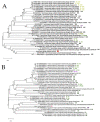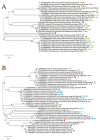Analysis of a Novel Bacteriophage vB_AchrS_AchV4 Highlights the Diversity of Achromobacter Viruses
- PMID: 33673419
- PMCID: PMC7996906
- DOI: 10.3390/v13030374
Analysis of a Novel Bacteriophage vB_AchrS_AchV4 Highlights the Diversity of Achromobacter Viruses
Abstract
Achromobacter spp. are ubiquitous in nature and are increasingly being recognized as emerging nosocomial pathogens. Nevertheless, to date, only 30 complete genome sequences of Achromobacter phages are available in GenBank, and nearly all of those phages were isolated on Achromobacter xylosoxidans. Here, we report the isolation and characterization of bacteriophage vB_AchrS_AchV4. To the best of our knowledge, vB_AchrS_AchV4 is the first virus isolated from Achromobacter spanius. Both vB_AchrS_AchV4 and its host, Achromobacter spanius RL_4, were isolated in Lithuania. VB_AchrS_AchV4 is a siphovirus, since it has an isometric head (64 ± 3.2 nm in diameter) and a non-contractile flexible tail (232 ± 5.4). The genome of vB_AchrS_AchV4 is a linear dsDNA molecule of 59,489 bp with a G+C content of 62.8%. It contains no tRNA genes, yet it includes 82 protein-coding genes, of which 27 have no homologues in phages. Using bioinformatics approaches, 36 vB_AchrS_AchV4 genes were given a putative function. A further four were annotated based on the results of LC-MS/MS. Comparative analyses revealed that vB_AchrS_AchV4 is a singleton siphovirus with no close relatives among known tailed phages. In summary, this work not only describes a novel and unique phage, but also advances our knowledge of genetic diversity and evolution of Achromobacter bacteriophages.
Keywords: Achromobacter; Siphoviridae; bacteriophage.
Conflict of interest statement
The authors declare no conflict of interest. The funders had no role in the design of the study; in the collection, analyses, or interpretation of data; in the writing of the manuscript, or in the decision to publish the results.
Figures







Similar articles
-
Molecular Analysis of Arthrobacter Myovirus vB_ArtM-ArV1: We Blame It on the Tail.J Virol. 2017 Mar 29;91(8):e00023-17. doi: 10.1128/JVI.00023-17. Print 2017 Apr 15. J Virol. 2017. PMID: 28122988 Free PMC article.
-
Characterization, sequencing and comparative genomic analysis of vB_AbaM-IME-AB2, a novel lytic bacteriophage that infects multidrug-resistant Acinetobacter baumannii clinical isolates.BMC Microbiol. 2014 Jul 5;14:181. doi: 10.1186/1471-2180-14-181. BMC Microbiol. 2014. PMID: 24996449 Free PMC article.
-
Characterization of the temperate phage vB_RleM_PPF1 and its site-specific integration into the Rhizobium leguminosarum F1 genome.Mol Genet Genomics. 2016 Feb;291(1):349-62. doi: 10.1007/s00438-015-1113-8. Epub 2015 Sep 16. Mol Genet Genomics. 2016. PMID: 26377943
-
Characterization and genomic analysis of the first Oceanospirillum phage, vB_OliS_GJ44, representing a novel siphoviral cluster.BMC Genomics. 2021 Sep 20;22(1):675. doi: 10.1186/s12864-021-07978-4. BMC Genomics. 2021. PMID: 34544379 Free PMC article.
-
Pantoeaagglomerans-Infecting Bacteriophage vB_PagS_AAS21: A Cold-Adapted Virus Representing a Novel Genus within the Family Siphoviridae.Viruses. 2020 Apr 23;12(4):479. doi: 10.3390/v12040479. Viruses. 2020. PMID: 32340233 Free PMC article.
Cited by
-
Characterization and complete genome analysis of Klebsiella phage Kp109 with lytic activity against Klebsiella pneumoniae.Virus Genes. 2024 Apr;60(2):222-234. doi: 10.1007/s11262-024-02053-y. Epub 2024 Jan 27. Virus Genes. 2024. PMID: 38279974
-
SGP-C: A Broad Host Range Temperate Bacteriophage; Against Salmonella gallinarum.Front Microbiol. 2022 Jan 12;12:768931. doi: 10.3389/fmicb.2021.768931. eCollection 2021. Front Microbiol. 2022. PMID: 35095790 Free PMC article.
-
Physicochemical, genomic, and phenotypic characterization of Escherichia phage BME3.Microbiol Spectr. 2025 Jul;13(7):e0130124. doi: 10.1128/spectrum.01301-24. Epub 2025 May 22. Microbiol Spectr. 2025. PMID: 40401929 Free PMC article.
-
Isolation, characterization, and genome analysis of a broad host range Salmonella phage vB_SenS_TUMS_E4: a candidate bacteriophage for biocontrol.Vet Res Commun. 2023 Sep;47(3):1493-1503. doi: 10.1007/s11259-023-10105-1. Epub 2023 Apr 25. Vet Res Commun. 2023. PMID: 37097546
-
Mining of Thousands of Prokaryotic Genomes Reveals High Abundance of Prophages with a Strictly Narrow Host Range.mSystems. 2022 Aug 30;7(4):e0032622. doi: 10.1128/msystems.00326-22. Epub 2022 Jul 26. mSystems. 2022. PMID: 35880895 Free PMC article.
References
-
- Busse H.-J., Auling G. Achromobacter. In: Trujillo M.E., Dedysh S., DeVos P., Hedlund B., Kämpfer P., Rainey F.A., Whitman W.B., editors. Bergey’s Manual of Systematics of Archaea and Bacteria. John Wiley & Sons; Hoboken, NJ, USA: 2015. - DOI
-
- Kutanovas S., Karvelis L., Vaitekūnas J., Stankevičiūtė J., Gasparavičiūtė R., Meškys R. Isolation and characterization of novel pyridine dicarboxylic acid-degrading microorganisms. Chemija. 2016;27:74–83.
-
- Felgate H., Giannopoulos G., Sullivan M.J., Gates A.J., Clarke T.A., Baggs E., Rowley G., Richardson D.J. The impact of copper, nitrate and carbon status on the emission of nitrous oxide by two species of bacteria with biochemically distinct denitrification pathways. Environ. Microbiol. 2012;14:1788–1800. doi: 10.1111/j.1462-2920.2012.02789.x. - DOI - PubMed
-
- Edwards B.D., Greysson-Wong J., Somayaji R., Waddell B., Whelan F.J., Storey D.G., Rabin H.R., Surette M.G., Parkins M.D. Prevalence and Outcomes of Achromobacter Species Infections in Adults with Cystic Fibrosis: A North American Cohort Study. J. Clin. Microbiol. 2017;55:2074–2085. doi: 10.1128/JCM.02556-16. - DOI - PMC - PubMed
Publication types
MeSH terms
Substances
Supplementary concepts
LinkOut - more resources
Full Text Sources
Other Literature Sources
Molecular Biology Databases
Miscellaneous

